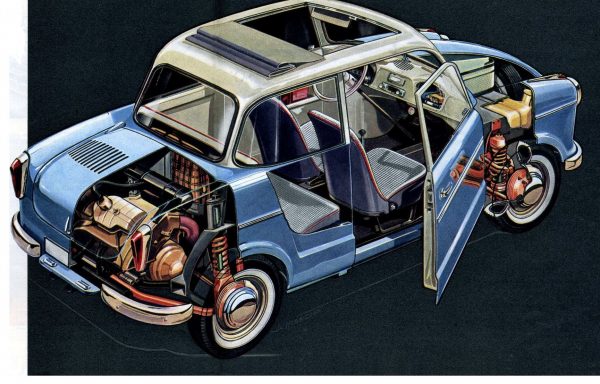NSU Autonova GT
The Bold Experiment
The NSU Autonova GT, introduced in the early 1960s, was a striking compact sports coupe that showcased NSU’s commitment to innovation and unique design. As one of the first cars to feature a fiberglass body, the Autonova GT aimed to combine lightweight construction with sporty performance, appealing to a new generation of driving enthusiasts.
The NSU Autonova GT was a striking concept car designed in the 1960s by a team of German automotive designers who aimed to explore advanced concepts in vehicle functionality and aerodynamics. Built on an NSU chassis and incorporating NSU’s Wankel rotary engine technology, the Autonova GT was a forward-thinking study that emphasized innovative design elements that would influence sports car aesthetics and engineering for years to come.
Historical Background
The NSU Autonova GT was developed in 1965 as a collaborative project by Pio Manzù, Michael Conrad, and Fritz B. Busch under the experimental Autonova brand. It was showcased as an avant-garde concept vehicle, presented at the 1965 Frankfurt Motor Show, where it attracted attention for its unique, wedge-like design and minimalist interior. The car was based on the NSU Sport Prinz platform, featuring a Wankel rotary engine and a lightweight fiberglass body.
Although the Autonova GT never went into mass production, it served as an inspiration for future vehicle design, influencing sports car styling, functional interiors, and aerodynamics during the late 1960s and early 1970s.
Technical Specifications
The NSU Autonova GT was designed with a focus on lightweight materials and a compact, powerful rotary engine. Here are its technical details:
- Displacement: 498 cc per rotor (NSU twin-rotor Wankel engine)
- Compression Ratio: Approximately 9.0:1
- HP Output: Estimated 100 hp at 6,000 rpm
- Torque Output: Approximately 13 kg/m at 4,500 rpm
- Transmission: 4-speed manual
- Length: 3,810 mm
- Width: 1,570 mm
- Height: 1,070 mm
- Weight: Approximately 700 kg
- Wheelbase: 2,200 mm
- 0-100 km/h: Approximately 10 seconds
- Top Speed: Around 180 km/h
Design and Mechanical Features
The Autonova GT was a design-forward project that emphasized advanced materials, aerodynamics, and streamlined functionality in every aspect.
- Wankel Rotary Engine:
- The Autonova GT featured NSU’s innovative twin-rotor Wankel engine, which was compact and lightweight, fitting well into the car’s aerodynamic, low-slung body. The rotary engine’s smooth power delivery and high-revving nature aligned with the car’s performance-oriented goals.
- The Wankel engine’s compactness allowed for a low and sleek body design, which emphasized the car’s futuristic aesthetic.
- Fiberglass Body:
- The body of the Autonova GT was crafted from lightweight fiberglass, a choice that reduced weight while allowing the designers to experiment with its unique shape.
- This material also contributed to the car’s distinct wedge shape, which was unconventional at the time and influenced future sports car designs by providing improved aerodynamic properties.
- Aerodynamic, Wedge-Shaped Design:
- The car’s wedge shape was revolutionary, as it minimized drag and maximized airflow efficiency. This design approach was novel for the 1960s and later became a popular design language for sports cars and supercars of the 1970s.
- The low roofline and wide stance gave the car a planted, stable appearance, and the large glass surfaces provided enhanced visibility.
- Minimalist Interior:
- The Autonova GT’s interior was spartan yet functional, designed around the principles of ergonomics and driver-centric controls. The dashboard was minimal, with only essential instruments and gauges.
- It featured bucket seats, a basic steering wheel, and a clean layout, in keeping with the car’s focus on the driver’s experience rather than luxury. This minimalist interior design would later influence future sports car interiors by focusing on a clean, functional look.
- Suspension and Braking:
- Front Suspension: The GT was equipped with independent front suspension, which contributed to its responsive handling.
- Rear Suspension: It featured a rear swing axle, optimized for stability at higher speeds.
- Braking System: The car had disc brakes at the front and drum brakes at the rear, which were sufficient for the lightweight body and added stopping power for a car of its time.
Driving Experience and Performance
The NSU Autonova GT was conceptualized as a performance-oriented vehicle, with driving characteristics that were both agile and responsive. Thanks to its lightweight construction and Wankel engine, the car was nimble and quick, capable of respectable acceleration and top speed for its time. The low center of gravity and aerodynamic shape allowed it to handle well in corners, while the minimalist interior put the driver in control without distractions.
The rotary engine’s high-revving nature provided a unique driving experience, with a smooth power curve that gave the car a sporty and engaging feel. Though it was never widely tested in real-world conditions, the Autonova GT was envisioned as a car that could deliver an exhilarating performance within the constraints of a concept vehicle.
Legacy and Impact
The NSU Autonova GT remains an iconic concept car from the 1960s, remembered for its daring design and innovative features. Although it never saw mass production, its influence can be seen in the design of future sports cars that adopted its wedge-shaped body, minimalist interior, and focus on aerodynamics.
The Autonova GT was also a testament to the potential of the Wankel rotary engine in performance cars, helping solidify NSU’s legacy as an innovator in automotive engineering. Today, it is regarded as a visionary project that demonstrated the possibilities of compact design, advanced materials, and rotary power. The few surviving units of the Autonova GT are considered highly valuable collector’s items, appreciated for their unique blend of aesthetics, engineering, and forward-thinking design philosophy.




